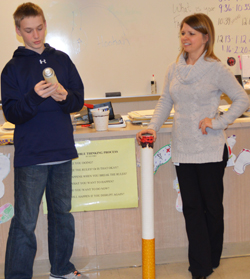One by one, Comstock Park’s Mill Creek Middle School students walked to the front of the classroom, picked up items containing toxins and placed them inside a gigantic, fake, hollow cigarette.
Methane gas, carbon monoxide, lead, formaldehyde, rabbit repellant, nickel … the list of poisons mounted until the cylinder was full. “Cigarettes contain more than 4,000 chemicals,” said Kent County Health Department health educator Tracy Malinowski. “It’s possible they could have up to 7,000. It’s a lot.”
While students looked at real samples of damaged lung tissue, she rattled off the common side-effects of long-term exposure to cigarettes: heart problems, emphysema and lung cancer.
Seventh-grader CJ Phinney said he was surprised by the number. “I knew there were a lot of chemicals and I knew they were harmful, but I didn’t know there were that many,” he said.
Students in Mill Creek’s seventh-grade health class are participating in 15 one-hour LifeSkills classes offered through the Kent County Health Department. Topics focus on drug and alcohol use and factors that influence decision-making such as self image, goals, assertiveness, communication skills and stress and anxiety.
It’s all correlated, Malinowski said. If students can better deal with struggles and consider their goals when faced with poor choices, they are less likely to use drugs and alcohol. “There’s a large component of social skills and goal-setting, which all relates to substance-abuse prevention,” she said.
The Botvin LifeSkills Training program is based on more than 30 years of peer-reviewed scientific research, which shows the program is effective in cutting tobacco use by 87 percent, alcohol use by 60 percent and marijuana use by 75 percent, according to the LifeSkills Training website.

Alcohol, Tobacco Use Down, Marijuana Up
A nationwide survey shows alcohol use and smoking among teenagers has decreased, but marijuana use is on the rise.
From 1991–2013, cigarette use among ninth through 12th-graders dropped from 27 percent to 15.7 percent. During 1991-2013, alcohol use declined from 50.8 to 34.9 percent. In Michigan, 28.3 percent of students reported drinking alcohol in 2013, according to the Centers for Disease Control and Prevention’s Youth Risk Behavior Surveillance survey of ninth through 12th-graders.
According to the survey, 15.7 percent of students had smoked cigarettes on at least one day during the previous 30 days and 8.8 percent had used smokeless tobacco. In Michigan, that percentage was 11.8 for cigarettes and 6.9 percent for smokeless tobacco use.
But during the same time period, marijuana use (one or more times during the 30 days before taking the survey) increased from 14.7 to 23.4 percent. In Michigan, 18.9 percent reported using marijuana.
Kent County has offered school-based programs for elementary through high school students for more than a decade. Malinowski said they are keeping an eye on new trends in drug use.

Marijuana and e-cigarettes are currently on the radar because of new laws regarding marijuana use and because research on e-cigarette effects is limited.
Also, prescription drug abuse has evolved from students sharing their own medications to raiding parents’ medicine cabinets. “The last five to seven years has been all about Adderall and ADD meds; now they have graduated to mom and dad’s drugs,” Malinowski said. “They are getting smarter younger, and we have a lot of people medicated for a lot of reasons.”
Students receive a plethora of mixed messages about marijuana because of its medicinal uses and the new trend of commercial grow houses, she said. But teenagers, whose brains are still developing, are vulnerable to harmful side effects. “They are hearing so many messages from people about what is damaging and what is not,” she said.
The course also covers “natural highs,” ways to feel good without substance use such as exercise and other recreational activities. Setting goals is a motivator.
Student CJ Phinney updated Malinowski on his goal: improving his writing. He’s started a fiction story, and said pursuing his dream makes him more likely to make positive choices. “If you have your life planned out, you know what you want to do and what you don’t what to do,” he said.
CONNECT
Kent County Health Education Programs









